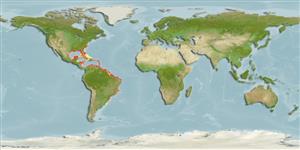أشلاق (القروش و الشفانين) (sharks and rays) >
Torpediniformes (Electric rays) >
Narcinidae (Numbfishes)
Etymology: Narcine: Greek, narke = numbness (Ref. 45335).
Environment: milieu / climate zone / depth range / distribution range
البيئة
بحري مرتبطة بالشعاب; نطاق العمق 1 - 43 m (Ref. 13608). Subtropical; 37°N - 39°S, 98°W - 34°W
Western Atlantic: Espirito Santo, Brazil to northern Argentina (Carvalho, pers. comm.). North Carolina, USA to Florida, northern Gulf of Mexico, central Lesser Antilles and Yucatan (Ref. 26938).
Length at first maturity / الحجم / وزن / العمر
Maturity: Lm 28.8 range ? - ? cm
Max length : 54.0 cm WD ذكر/ مختلط الجنس; (Ref. 26340); common length : 35.0 cm WD ذكر/ مختلط الجنس; (Ref. 5217); أعلا وزن تم نشرة: 650.00 g (Ref. 6902)
وصف مختصر
مفاتيح التعريف | الوصف الخارجي | قياسات المظهر الخارجي
A pale sand-colored ray, often with ellipses of dark spots on dorsal side of rounded disk (Ref. 26938). Grayish to reddish brown, many rounded blotches outlined with blackish spots. Dark bands across tail up to dorsal fin. Snout darkened (Ref. 7251).
Inhabits coastal waters, on sand or mud bottoms (Ref. 26340). Common along sandy shorelines, sometimes near coral reefs (Ref. 12951). Aggregates in shallow waters ca. 10-20 m deep during summer and autumn months, dispersing to deeper waters during winter (Ref. 114953). Buries itself with only eyes protruding (Ref. 12951). Nocturnal, moves to shallow bays at night to feed; prefers worms, but may take juvenile snake eels, anemones, and, small crustaceans (Ref. 12951). Produces broods of 4 to 15 young (Ref. 26938). Reaches ca. 45 cm TL. Both sexes mature by 27 cm TL; birth size at ca. 11 cm TL (Ref. 114953). Can discharge between 14 and 37 volts. Contact with the skin can produce a severe electric shock. In addition to the main electric organ, this species possesses a bilateral accessory electric organ (Ref. 10011) speculated to have a possible role in social communication (Ref. 10489). Reported to taste good, but not fished commercially. Traded as an aquarium fish at Ceará, Brazil (Ref. 49392).
Life cycle and mating behavior
Maturities | التكاثر | Spawnings | Egg(s) | Fecundities | Larvae
Ovoviviparous. Sex ratio of embryos is about one to one, however, small mothers may have predominantly female embryos and that for a given mother, embryos tend to be of one sex (Ref. 46979). Maximum number of embryos per female may reach 15. The young are capable of giving off electric charges even before they are released from the womb (Ref. 46978).
Robins, C.R. and G.C. Ray, 1986. A field guide to Atlantic coast fishes of North America. Houghton Mifflin Company, Boston, U.S.A. 354 p. (Ref. 7251)
IUCN Red List Status (Ref. 130435)
استخدامات بشرية
مصائد: مصائد تستهلك محلينا; حوض مائي: تجاري
أدوات
تقارير خاصة
Download XML
مصادر علي الأنترنت
Estimates based on models
Preferred temperature (Ref.
123201): 22.9 - 28, mean 25.6 °C (based on 442 cells).
Phylogenetic diversity index (Ref.
82804): PD
50 = 0.5000 [Uniqueness, from 0.5 = low to 2.0 = high].
Bayesian length-weight: a=0.01122 (0.00605 - 0.02082), b=2.90 (2.73 - 3.07), in cm total length, based on LWR estimates for this species & (Sub)family-body (Ref.
93245).
مستوى غذائي (Ref.
69278): 3.2 ±0.4 se; based on diet studies.
المرونه (Ref.
120179): منخفض, الحد الزمني الأدني لتضاعف عدد أفراد المجتمع 4.5-14 سنة (Assuming fecundity<100).
Fishing Vulnerability (Ref.
59153): Low to moderate vulnerability (34 of 100).
Nutrients (Ref.
124155): Calcium = 6.47 [0.67, 106.25] mg/100g; Iron = 0.472 [0.039, 5.319] mg/100g; Protein = 16.6 [12.4, 21.0] %; Omega3 = 0.145 [0.049, 0.421] g/100g; Selenium = 14.3 [2.3, 70.5] μg/100g; VitaminA = 22.2 [1.8, 283.1] μg/100g; Zinc = 0.82 [0.06, 9.22] mg/100g (wet weight);
